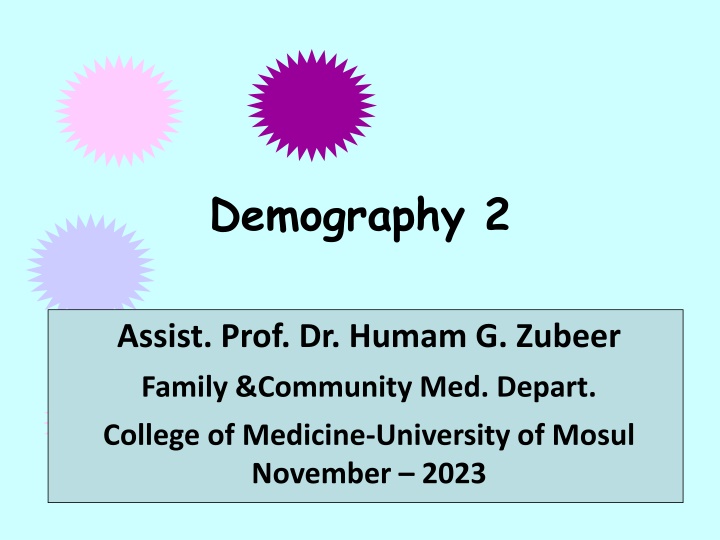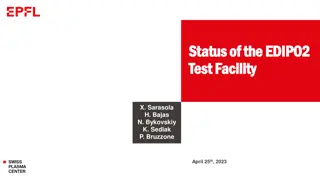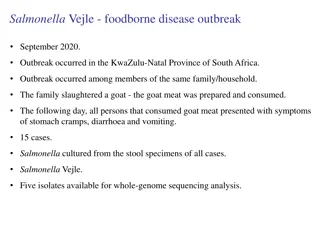
Organizational Steps for Population Censuses and Data Organization
Explore the systematic process involved in conducting national and local population censuses, including steps like choosing questions, form design, staff recruitment and training, data organization, and result publication. Learn about the characteristics of the population that can be surveyed, potential challenges in defining characteristics like age and place of residence, and the vital role of census data in health planning.
Download Presentation

Please find below an Image/Link to download the presentation.
The content on the website is provided AS IS for your information and personal use only. It may not be sold, licensed, or shared on other websites without obtaining consent from the author. If you encounter any issues during the download, it is possible that the publisher has removed the file from their server.
You are allowed to download the files provided on this website for personal or commercial use, subject to the condition that they are used lawfully. All files are the property of their respective owners.
The content on the website is provided AS IS for your information and personal use only. It may not be sold, licensed, or shared on other websites without obtaining consent from the author.
E N D
Presentation Transcript
Demography 2 Assist. Prof. Dr. Humam G. Zubeer Family &Community Med. Depart. College of Medicine-University of Mosul November 2023
Organizational steps for national and local population censuses 1. Choice of questions to be asked. Statement of the reason for census 2. 3. 4. 5. 6. 7. Design of the form. Recruitment of census staff. Training of recruited staff. Testing the form. Dealing with financial and legal aspects. Enumeration area i.e.demarcation, including numbering of houses. Population enumeration (preliminary and final). 8.
Data organization leading to publication of results: The following steps should be taken: 1. Coding and checking. 2. Producing computer data files. 3. Preliminary tabulation and initial publications. 4. Consideration of results and detailed publications.
Characteristics of the population In a population census , information may be collected about the following characteristics Age Sex Marital status. Area of residence Literacy Occupation Economic activity Relationship within a household etc.
Problems in definition of characteristics: Problems may arise in defining the following characteristics 1- Age : concept of completed years of age, ( birth certificate), estimated on the basis of growth, milestones, estimated on the basis of calendar of events, guessed.
2- Place of residence: Permanent. Temporary. 3- Occupation Multiplicity of possible occupation. Past occupation. 4- Relationships and marital status
Uses of census data in health field: For planning health services. As a source of denominators for health indicators. Census population: Number of population in census year Estimated population: Number of population in any inter census year obtained by applying methods of estimation of census population. Mid year population
Age and sex structure After the size of the population, the age and sex structure is one of the first results of the census.
Age and sex structure The composition of age and sex structure is of particular importance regarding the potentialities of population e.g.: The proportion of children determines the present weight of education and the future size of the economically active population.
Age and sex structure The proportion of women in childbearing age (15-49 years) determine number of births that can be expected in the following years.
Population Pyramid The graphic presentation of the age and sex structures . It is made of a number of horizontal strata: Younger ages below 15 yrs form the base layer Elderly 65 yrs form the apex. In between age groups of 15-59 yrs form strata of the body of pyramid.
Shape of pyramid it varies in different countries according to relative structure of each age and sex group. sex by age group Relative structure = x K total population
Relative structure Age group Male Female Total Female Male 0-4 5-9 10-14 15-19 20-25 > > > 65+ K=1000 Total
General outline of population pyramid is triangle The shape can be affected by: 1- Mortality : The old generation can be reduced by mortality. 2- Fertility: It determine the base. 3- Migration: It may affect one sex and /or certain age group
Characteristic of Iraqi population pyramid 1. Broad base due to high fertility . <15 yrs forms >40% of the population in comparison to narrow base layer of developed countries (about 23% of the population ).
Characteristic of Iraqi population pyramid 2. Narrow top of the pyramid due to the smaller proportion of elderly (65+) which is about 4 % in comparison to the flat top in developed countries pyramid which is due to high proportion of this age group
Characteristic of Iraqi population pyramid 3. Sex distribution The male to female ratio shows insignificant difference.
Iraqi pyramid 10-15 0-10 10 9 8 7 6 5 4 3 2 female male
Developed countries pyramid 75+ 15-19 10-15 5-9 0 - 5
The mean age of the population is the arithmetic mean age of all population. Most developing countries population have a young mean age. The relative size of young and old age groups shows the weight of inactive age group in comparison with the potentially active ones.
There is a great difference between developed and developing countries: Age group 0-14 15 64 65+ developed 26% 63.6% 9.7-20% developing 40.5% 55.6% 3.9% Iraq 49% 47% 4% (0-14) + (65+) Dependency ratio = x100 (15-64)
Sex ratio Ratio (male to female ratio): The population pyramid is never symmetrical At birth 105 boys/100 girls. After birth mortality doesn't affect both sexes with the same manner at the same age. There is excess male mortality at all ages . Migration has an effect on sex ratio too. no. of Sex Ratio = no. of Over all= 107:100 1.07:1
Other population structures School attendance 1.School enrollment rate i.e. the relation between the enrolled in school population and the population school age. 2. School attendance rate i.e. the rate between population present at schools and the population enrolled in schools. Enrolled Age Total population 228600 x K Enrollment rate% 6- 7- 8- 124300 Overall ratio Total
Other population structures Economic activity no. of active population by age /sex activity rate = x K total population no. of unemployed Un-employed rate = x K total population (0-14) + (65+) Dependency rate = X100 (15-64)
Other population structures Household Family couple of parents and their children (biological family) Extended Nuclear Consanguine Communal Household is the entity that consists of individuals who live in the same dwelling. Thus a household can be of several families. Private household i.e. one or more several families in the household . Institutional household (non family) i.e. people living together in certain institution .
Size of house hold It differs from no. of persons Crowding index = no. of rooms






















